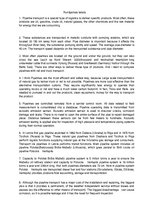Runājamais teksts
1. Pipeline transport is a special type of logistics to deliver specific products. Most often, these products are oil, gasoline, crude oil, natural gasses, the other chemicals and the raw material for energy that we are consuming.
2. These substances are transported in metallic conduits with pumping stations, which are located 30-150 km away from each other. Pipe diameter is important because it affects the throughput (flow rate), the substance pumping ability and speed. The average pipe diameter is 40 cm. The transport speed depends on the transported substance and pipe diameter.
3. Most often pipelines are located on the ground and under the ground, but they can also cross the sea (such as Nord Stream 1220(thousand and twohudred twenty)km-long underwater cable that connects Vyborg (Russia) and Greifswald (Germany) harbor through the Baltic Sea). There are other ways to deliver these type of products. And i want to compare pipelines with rail and truck transport.
4. I think Pipelines are the most efficient and safest way, because Large-scale transportation of natural gas by tanker truck or rail is not possible. Pipelines are more cost-effective than the alternative transportation options. They require significantly less energy to operate than operating trucks or rail and have a much lower carbon footprint. In fact, Truks and Rails are needed to pumped in and out the produckt, clean equipment, money for the way to transport the product.
…















